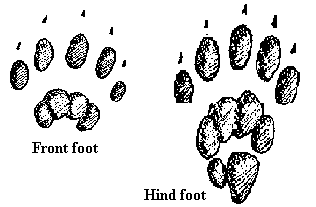![]() Spotted Skunk
Spotted Skunk ![]()

Spotted Skunk Tracks


![]() Natural History of Spotted Skunks
Natural History of Spotted Skunks ![]()
The spotted skunk, also known as the hydrophobia cat or the civet cat, is the size of a small domestic cat, about half the size of a striped skunk. They are more social than other skunks. Several may share a den over the winter. They den in hollow logs, brush piles, and the burrows of other animals. The spotted skunk is the most carnivorous of all skunks. It eats small mammals, insects, rats, mice, grapes, fruit, corn, and grubs. Owls are the primary predator of skunks. Owls can strike silently from above and carry off a young skunk before the parent can use its defensive spray. † Spotted skunks are good climbers and will climb trees to escape from predators. They are faster and more agile than striped skunks. In early spring, four to six blind, furred young are born. They don't have the distinctive black and white spotted fur coloration until early summer. The spotted skunk has a unique spraying behavior. When threatened, it will turn its back, do a handstand on its forefeet, raise its tail, and spray. It can accurately spray a predator 12 to 20 feet away. Most predators are wary and will back off when the skunk begins this display. Skunk scent comes from a chemical called methyl mercaptan and is carried in glands near the animalís tail. Spotted skunk tracks show five toes on each foot, with claw marks. The heel pad of the hind print is distinctively lobed. These skunks were hunted for their fine, silky pelts, which are very valuable. Spotted skunks have a home range of about 150 acres. They weigh one to two pounds and are about 1Ĺ feet long from nose to tip of tail. They den in dry places, beneath buildings, in tree cavities, or in rock piles.


![]() Personal Notes on Spotted Skunks
Personal Notes on Spotted Skunks ![]()
†
Find skunk posters, greeting cards, t-shirts, hats, and more in my new store.
|
Now available: "Animals Don't Cover
Their Tracks - An Introduction to Animal Tracking" on CD! (Version 3.0)
New drawings, more species, more photos, more extensive sections on tracking
humans, more detailed directions for plaster casting, mystery tracks section,
tracking stories section, and more. The CD features over 100 species, including
special bonus sections with the tracks of some African and Australian
animals. A large section on tracking lost people for search and rescue is
included, with over four pages of photos showing the details of tracks and
signs people leave. Easy to use format. This web site is limited
by bandwidth, but the CD-ROM is not. The CD is available in my online store at:
www.dirt-time.com
Works with Mac or PC. Happy tracking!!
What else can you find in the nature store? Beartracker's animal tracks coloring book, T-shirts, sweatshirts, journals, book bags, toddler and infant apparel, mouse pads, posters, postcards, coffee mugs, travel mugs, clocks, Frisbees, bumper stickers, hats, stickers, and many more items. All with tracks or paw prints, or nature scenes. Custom products are available. If you don't see the track you want on the product you want, email me and I can probably create it. Proceeds from all sales go to pay the monthly fees for this web site. You can help support this site as well as get great tracking products! Thank you! |
| Find other tracking products: www.zazzle.com/tracker8459* |
| Also visit these fine
stores for more products of interest: NDN Pride shop - For Indian Pride items for all tribes. Custom items available on request. ASL Signs of Love - For anyone who uses or is learning ASL, American Sign Language. Custom name items and more are available here. Sales from all stores give commissions to Beartracker's Animal Tracks Den, which helps keep this site online as a free service. We are celebrating ten years online this year! |




Got a skunk story? E-mail me and tell me about it.
Copyright © 1997-2008. Text and drawings by Kim A. Cabrera

